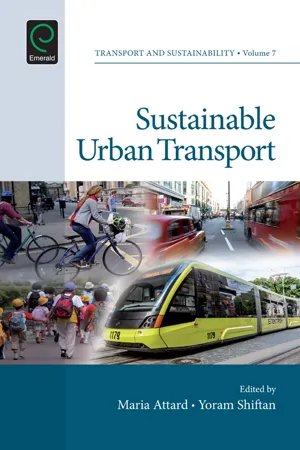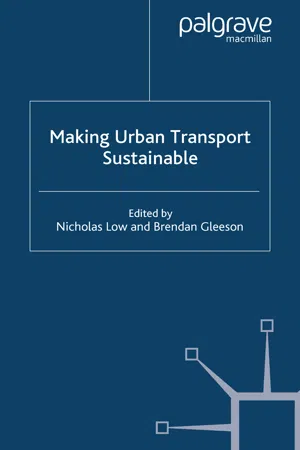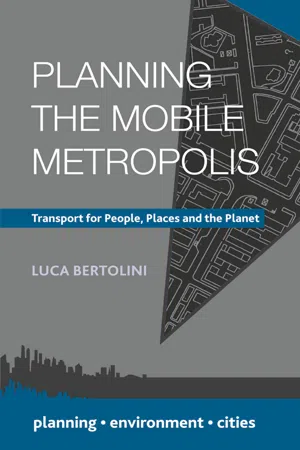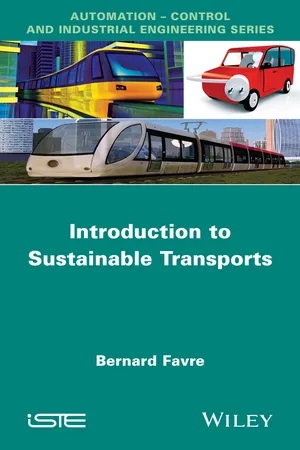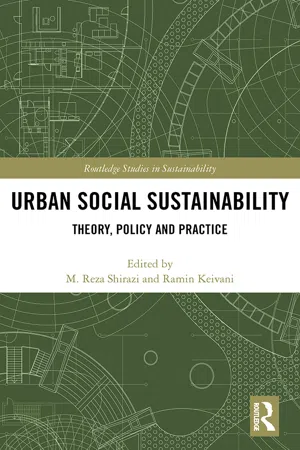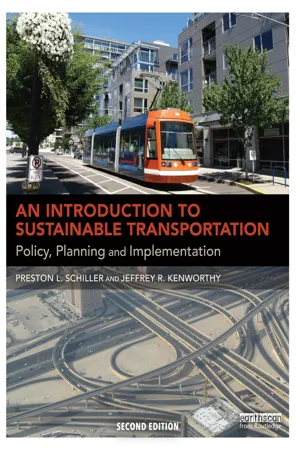Geography
Sustainable Urban Transport
Sustainable urban transport refers to transportation systems and infrastructure designed to minimize environmental impact, promote public health, and support social equity within urban areas. This includes initiatives such as public transit, cycling infrastructure, pedestrian-friendly urban design, and the use of clean energy vehicles. The goal is to create efficient, accessible, and environmentally friendly transportation options for urban residents.
Written by Perlego with AI-assistance
Related key terms
1 of 5
12 Key excerpts on "Sustainable Urban Transport"
- eBook - ePub
- V. Kelly Turner, David H. Kaplan, V. Kelly Turner, David H. Kaplan(Authors)
- 2021(Publication Date)
- Routledge(Publisher)
The focus of this review is the sustainability of transportation in the urban context. Transportation is intertwined with many aspects of urban geography and planning, especially when considering sustainability. The Brundtland Commission (1987) defined sustainable development as development that “meets the needs of the present without compromising the ability of future generations to meet their own needs.” (p. 8). Although the term “sustainability” was rarely used in urban transportation and urban geography until the early 1990s (Purvis & Grainger, 2004), concerns over the development of transportation systems and their associated impacts on urban form, air quality, and society go back over a century (Alonso, Monzón, & Cascajo, 2015; Carroll & Bovls, 1957; Dickinson, 1949; Kidd, 1992; Marble, 1959; Pratt, 1911; Stradling & Thorsheim, 1999; Taylor, 1915).Urban transport systems today are largely motorized, dependent on nonrenewable fossil fuels (Black, 2010). Emissions from vehicles contribute significantly to both climate change and the degradation of urban air quality (Chapman, 2007; U.N. Habitat, 2016). Traffic congestion causes substantial economic losses in wasted time and fuel (Downs, 2005). The geographic organization of land use and transport infrastructure in our cities can promote social equity (Curtis, 2008; Van Wee & Handy, 2016) or lead to social exclusion for disadvantaged groups (El-Geneidy et al., 2016; Lucas, Van Wee, & Maat, 2016; Manaugh & El-Geneidy, 2012). New research has begun to show that transport systems affect our happiness (Pfeiffer & Cloutier, 2016) and overall quality of life (Bäckström, Sandow, & Westerlund, 2016; Bergstad et al., 2011; Friman, Fujii, Ettema, Gärling, & Olsson, 2013).This paper reviews the literature on urban transportation sustainability using three frameworks. First, the goals of transportation sustainability are summarized in three fundamental “pillars” of environmental, social, and economic quality (Gudmundsson, Hall, Marsden, & Zietsman, 2016). The unsustainability of urban transportation systems can also be understood via these three pillars. Second, the literature on sustainable transport solutions is often divided into narrow and broad approaches (Litman & Burwell, 2006), as summarized in Figure 1. - eBook - PDF
- Maria Attard, Yoram Shiftan, Maria Attard, Yoram Shiftan(Authors)
- 2015(Publication Date)
- Emerald Group Publishing Limited(Publisher)
CHAPTER 1 Sustainable Urban Transport AN INTRODUCTION Maria Attard and Yoram Shiftan INTRODUCTION As more people choose to live in urban areas, a key element for the success and sustainability of cities is a transport system that is able to meet the needs for economic growth and at the same time care for the environment and people’s quality of life. This is challenged by the positive contributions of transport to society in terms of opportunities for employment, education and leisure, and at the same time the high costs associated with pollution, congestion, traffic crashes, noise and other externalities. Sustainable Urban Transport is an attempt to contribute positively to communities and their built environments. Environmentalists, policy makers and planners have used the term sus-tainability for many years now and it is a term that has come to embrace concerns about the social, as well as the physical environment. These con-cerns range from the immediate and short-term such as health, road safety and social exclusion to the very long-term such as the security of energy supplies and climate change. In the absence of convergence on an agreed meaning for the term, sustainability or sustainable has come to be Sustainable Urban Transport Transport and Sustainability, Volume 7, xv xxvi Copyright r 2015 by Emerald Group Publishing Limited All rights of reproduction in any form reserved ISSN: 2044-9941/doi: 10.1108/S2044-994120150000007026 xv used rather loosely as an adjective that is applied to projects or policies that are judged to be less harmful than those that they are replacing. Trends and policies that are unsustainable are easier to recognize than those that are definitely sustainable particularly given the technical and scientific uncertainties about the future. - eBook - PDF
- N. Low, B. Gleeson, N. Low, B. Gleeson(Authors)
- 2002(Publication Date)
- Palgrave Macmillan(Publisher)
1 Is Urban Transport Sustainable? Nicholas Low Introduction Once the privilege of the elite, personal mobility is a freedom bestowed by modernity on the general public through technology. The physical nego- tiation of space by people in pursuit of social values (access to work, friends, child care, education, recreation and supplying the home) is part of urban social life. Road freight vehicles provide a flexibility of supply that keeps profits up and costs down for businesses in the ‘consuming’ city. But the benefits of freedom and flexibility are illusory if the opportunity costs of providing for unending mobility are never considered, distances to be cov- ered increase, travel becomes a compulsory, stressful, dangerous and expen- sive routine and the costs of mobility are merely shifted from the individual to society and the environment. This book explores how the real benefits of mobility can be protected and the costs properly allocated and contained. The chapters examine the sustainability of the world’s urban transport systems, bringing a variety of perspectives from different nations and from different fields: engineering, sociology, critical geography, environmental economics, eco-politics, urban planning and transport planning. What does ‘sustainability’ mean? The question will be approached from a familiar perspective, that of the triad – economic, social and environmental sustainability. In the ‘triple bottom line’ variant, this perspective requires that corporations and governments seek the simultaneous achievement of three fundamental goals: economic profitability, social responsibility and environmental conservation (Elkington, 1998). Our analysis shows, how- ever, that such an outcome is contingent on power and commitment. There is no necessary correspondence between economic, social and environmental sustainability. - eBook - PDF
Urban Development for the 21st Century
Managing Resources and Creating Infrastructure
- Kimberly Etingoff(Author)
- 2015(Publication Date)
- Apple Academic Press(Publisher)
6.5 TOWARD SUSTAINABLE TRANSPORT It is increasingly recognized that sustainability in the urban transportation realm must be pursued and achieved on multiple fronts—environmentally, socially, and economically. This section addresses these challenges. 6.5.1 ENVIRONMENTAL SUSTAINABILITY The urban transport sector’s ecological footprint is enormous and expand-ing. Many environmental problems in the urban transport sector are rooted in its reliance on petroleum, the automotive fuel source of choice, to pro-pel motor vehicles, increasingly ones that are privately owned and used. The share of the world’s oil consumption accounted for by transportation rose from 45.2 percent in 1973 to 61.7 percent in 2009, and the sector is expected to continue to drive the growth in oil demand (IEA, 2011). World reserves of conventional oil exceed what has been used to date, but with rapid motorization and thus increasing demands for oil, many observe be-lieve it is unlikely that this energy source will last beyond the mid-century mark. Rising GHG emissions and global temperatures as well as levels of photochemical smog and particulates in urban air basins further under-score the urgency of weaning the sector from its dependency on oil and more generally auto-mobility. A combination of technological advances, demand management, and externality-based pricing will be critical in 164 Urban Development for the Twenty-First Century charting an environmentally sustainable future in the urban transport sec-tor. On the technological front, clean-fuel vehicles and information sys-tems that enable innovations like dynamic ridesharing and carsharing, will have pivotal roles to play. Reducing the demand for indiscriminant auto-mobility, such as by designing compact, mixed-use cities that shorten trips and encourage NMT, will also be important. Setting price signals so that polluters and those driving in rush hours internalize costs are similarly part of the environmental sustainability equation. - eBook - PDF
Planning the Mobile Metropolis
Transport for People, Places and the Planet
- Luca Bertolini(Author)
- 2017(Publication Date)
- Red Globe Press(Publisher)
(European Commission, n.d. a) Leading transport academic David Banister contends that: The prime objective of sustainable urban development should be to facilitate that development whilst at the same time ensuring that the use of carbon resources are within the limits of sustainability, and that all individuals have access to that development in terms of their welfare and well-being. (Banister, 2005 , p. 2) Even an industrial think tank such as the World Business Council for Sustainable Development (WBCSD), in which the automobile and oil industries participate, agrees that: For mobility to be sustainable, it must improve accessibility while avoiding disruptions in societal, environmental, and economic well-being that more than offset the benefits of the accessibility improvements. (WBCSD, 2001 , pp. 1–7) These views are representative of others in the government, aca-demic and private fields. The consensus is, however, often only apparent, and disputes arise when moving from the identification of problems to the search for solutions. For Banister, for instance, change in travel behaviour (i.e. travelling less, and when travelling, travelling by collective and non-motorized modes) is an essential Integrating Urban and Transport Planning 103 part of the solution (Banister, 2008 ). In a follow-up document to their 2001 study, the WBCSD ( 2004 ) focuses instead almost exclu-sively on technological solutions (i.e. making cars and trucks more environmentally efficient). The European Commission juggles ambivalently between the two directions, with some components of the major, recently launched Horizon 2020 research and devel-opment programme solely betting on the technological card and other parts also acknowledging the need for behavioural change (European Commission, n.d. b). These distinctions and ambiva-lences are representative of those of other participants in the debate. - eBook - ePub
- Bernard Favre(Author)
- 2014(Publication Date)
- Wiley-ISTE(Publisher)
The requirements linked to transport security are also proving to be strongly “dimensioning”: the ability of an organization or a transport system to prevent the risk of deliberate malevolence, or to reduce its effects, must be strengthened. Under certain circumstances, transport is targeted by actions that aim to harm the integrity of users, workers, carried goods and resident populations. Some striking examples can be recalled (such as the infamous 9/11 attack in 2001).Figure 1.1 shows a synthesis of the ingredients for transport, which appears in multidimensional form: elements in the context of societal, economic or technical order (in italics), challenges and objectives (framed), the “{mobility–productivity}, {environment–productivity}, {safety–security}” trio, to which the systemic anthropocentric “man and cooperative systems” is added, the latter being represented by a circle that symbolizes the interface with other associated systems (energy, materials, intelligence, etc.). However, man remains at the center of sustainable transport.Figure 1.1. Ingredients for sustainable transport. Context and challenges [FAV 07]1.2. Towns, territories and sustainable transport
Transport is to territory what blood is to living organisms: a vital function to supply and drain the territory, to move “nutrients” around, and to evacuate “waste”, which enables it to exist and develop harmoniously with the various systems that form its economic, social and environmental aspects.More than half of the world’s population already lives in cities and the trend will continue for the foreseeable future, particularly with the further emergence of “mega-cities” (23 towns with more than 10 million inhabitants in 2012).Improving urban mobility is one of the points included in the agenda of all governing bodies, from a local level to a global level: transport within towns to guarantee the movement of inhabitants for their daily activities, transport on the outskirts of these towns to link living and working zones, connecting these towns by intercity transport means to connect them to each other or to guarantee the supply of base materials and consumable goods, etc. The need for transport is therefore essentially associated with towns, which have both a systemic organization and uses it to impose the best possible integration of their transport systems into the urban structure. However, the provision and maintenance of infrastructure for transport, its operation, as well as programming and developing new infrastructure, are at the heart of political debates on the management of towns. They need areas of land in addition to financial resources and are in constant competition with the other main elements of urban fabric. The same holds true for the operation of infrastructures and the management of vehicles associated with them, particularly in terms of gas and noise emissions, congestion and safety. The development of public transport is also one of the main topics of urban politics. Strengthening the governance of transport systems in urban areas is perceived by public entities as an inescapable requirement for the sustainable development of towns, from economic, social and environmental points of view. Guaranteeing adequate needs for mobility and promoting transport solutions between public and private spheres have also been considered. In order to do this, initiatives to form partnerships have been encouraged. They can lead to regulations for the use of infrastructures serving urban territories. They can also put forward the development of integrated solutions for transport systems within urban systems, by handling vehicles, infrastructure, operators and operational rules in a coordinated manner. Public policies play a major role in steering the choice of the favored transport mode, investments, by controlling through regulations or promoting good practices. They must also arbitrate between a variety of constraints, of actors and of expectations. Private entities develop solutions for the transport market. They encourage innovations in the fields of energy, intelligence and materials. The evolution of technologies and services regularly provides pertinent solutions for urban transport, although they are used differently depending on the urban agglomeration and according to the region of the world being considered16 - eBook - PDF
- Solange Uwera(Author)
- 2019(Publication Date)
- Society Publishing(Publisher)
However, a requirement for such smart and smooth transport transition is a complete understanding of the overall urban transport system. The other aspects of smart transport, examining how can reduction of car travel demand itself by either encouraging a shift travel to other manners, or by reducing the demand for vehicular travel altogether (Figure 5.1). Metropolitan Accessibility and Transportation Sustainability 125 Figure 5.1: Parking strategies in sustainable cities. Source: www.flickr.com 5.6. PRINCIPLES OF URBAN TRANSPORT SYSTEMS PLANNING The urban transport system is a preemptive response to social and economic factors which in turn affected by environment. The urban transportation system is necessary for the connectivity of the urban area with the rural area which in altogether connects them to the world. The transportation system has its indirect link with land used development with its influence on the environment as well. They change accordingly if even one of those factors change. These changes are sometimes more or less then environment somewhat balances it making the system balanced. But if the changes are high enough to not get repaired by the other factors, then the system self-destructs on its own. Hence certain principles should be taken care in order of full proof transport systems planning. Some of these points which should be considered are as follows: • People and their need to have a certain class in traveling arrangements should be considered, and nobody wants to sit in never-ending traffic. They don’t want to walk tirelessly on difficult roads and should be able to safely drive their automobiles to their choice of destinations for creative interaction as well as affordable living. Since 21 st century is overflowing with choices, Metropolitan Sustainability 126 including non-mechanical, post-fossil fuel travel options. - eBook - ePub
Urban Social Sustainability
Theory, Policy and Practice
- M. Shirazi, Ramin Keivani, M. Reza Shirazi(Authors)
- 2019(Publication Date)
- Routledge(Publisher)
4 Social sustainability and transportMaking ‘smart mobility’ socially sustainable
Tanu Priya Uteng, Yamini Jain Singh, and Oddrun Helen Hagen
Social sustainability in the transport planning sector
The ethos of numbers and technocratic rationality overpowers other areas in transport-related development projects. Often expressed in ‘kilometres of roads constructed’, ‘numbers of new highways built’ in the past fiscal year, ‘time savings’ etc., the engineering and technical dimension routinely takes precedence. The essential denominator of development, i.e. the affected population, is given a backseat in a typical transport discourse and (aggregated) population ends up as mere numbers to be fed into the transport modelling exercises, typically projecting the need for capacity enhancement of road systems or mass transit systems. In this number-crunching exercise, only one pillar of sustainable development has historically been given priority – economic development. Increasing environmental awareness has led to altering this pattern by focusing on the goal of environmental protection along with economic efficiency. Despite this, the ways in which these ‘calculated and projected’ environmental and economic developments filter down to affect the general populace or the pillar of social sustainability remain largely ignored.For example, sieving through published works by the Transportation Research Board on sustainable transportation till 2014 suggests that the three thematic areas of sustainability (economic, environmental, social) are not equally represented in the transportation literature. Even though the term ‘sustainability’ surfaced only in 1980s, and research on the three themes of sustainability actually started to appear after the 1990s, research focus on economic and environmental sustainability is visible. Lineburg (2016: 11) plots the occurrence of each sustainability sector in the transportation literature till 2014 and highlights that environmental sustainability has had more attention in recent times than economic and social sustainability because there was high awareness of environmental crisis brought about through the use of fossil fuels in the transport sector. As noted by Jeekel (2017), the attention on social issues, although considered important in reaching sustainable development goals, lagged behind in both practice and research arenas. The topic of social sustainability, therefore, demands further study through bringing together ‘the relationships between individual actions and the created environment, or the interconnections between individual life-chances and institutional structures’ (Jarvis et al - eBook - PDF
Green Products
Perspectives on Innovation and Adoption
- Joao Neiva de Figueiredo, Mauro F Guillen(Authors)
- 2011(Publication Date)
- Productivity Press(Publisher)
Sustainable Urban Mass Transport • 85 The. economic. success. of. cities. is. based. on. agglomeration. economies,. which. enable. businesses. to. function. more. efficiently. in. proximity. to. a. dense.network.of.information,.employees,.suppliers,.and.customers . .As.a. result,.it.is.not.surprising.that.cities.depend.on.good.transportation.sys-tems.to.thrive . .Furthermore,.a.healthy.economy.requires.a.combination. of. public. and. private. modes. of. transportation. to. meet. the. varied. needs. of.the.population . .However,.the.high.labor.intensity.of.public.transport,. combined.with.a.variety.of.pressures.toward.more.dispersed.trip.patterns,. subjects. this. basic. service. to. severe. cost. pressures,. which. occasionally. erupt.in.cutbacks.or.unsustainable.fiscal.drains . .Meanwhile,.the.increase. in.private.car.use.and.traffic.congestion.continues.unabated . .The.adverse. environmental,.health,.and.social.effects.of.congestion.limit.the.sustain-ability.of.private.modes.of.transportation.in.the.long.term . .Thus,.an.inte-grated.urban.plan.including.sustainable.mobility.solutions.is.essential.to. the.survivability.of.tomorrow’s.urban.centers . 5.2.2 Environmental, Health, and Social Impact Problems.of.inadequate.infrastructure.have.economic.as.well.as.human. costs. .As.traffic.continues.to.clog.the.streets.of.most.large.cities.in.devel-oping. countries,. the. costs. of. traffic. congestion. grow . . Estimated. losses. TABLE 5.1 (continued) World’s.Most.Populated.Urban.Areas.in.2006 Rank City/Urban Area Country Population in 2006 (Millions) 38 Baghdad Iraq 6.06 39 Kinshasa Congo 5.89 40 Riyadh Saudi.Arabia 5 .76 41 Santiago Chile 5.7 42 Miami United.States 5 .48 43 Belo.Horizonte Brazil 5 .45 44 Philadelphia United.States 5 .36 45 St. .Petersburg Russia 5 .35 46 Ahmadabad India 5.34 47 Madrid Spain 5.17 48 Toronto Canada 5.16 49 Ho.Chi.Minh.City Vietnam 5 .1 50 Chongqing China 5.06 Source: . City.Mayors,.http://www .citymayors.com/statistics/urban_2006_1.html. - eBook - ePub
State of the World 2012
Moving Toward Sustainable Prosperity
- The The Worldwatch Institute(Author)
- 2012(Publication Date)
- Island Press(Publisher)
3 Table 4–1. Characteristics of Unmanaged Motorization and Sustainable TransportThe Arc of Sustainable Transport in International Agreements
The sustainability challenges facing individual cities and communities—from economic development to climate change—are challenges that are global in scope. They require a framework of commitment at the international level in order to provide incentives for global participation, support global initiatives, and monitor global progress toward goals. In 1992, Agenda 21 considered transportation a key program area for both resource management and for “improving the social, economic and environmental quality of human settlements.” It even went so far as to specifically call for efficient and cost-effective approaches such as integrated land use and transportation planning, high-occupancy public transport, safe cycleways and footpaths, international information exchange, and a reevaluation of present consumption and production patterns. Although transport was featured prominently, however, and even discussed in some depth, no targets, goals, commitments, or other forms of accountability were incorporated.The Kyoto Protocol adopted by 191 countries since 1997 established legally binding targets for an average reduction of 5 percent of global greenhouse gases relative to 1990 emissions by 2012. With its focus on using markets to find least-cost GHG reduction strategies, it avoided sectoral strategies and did not specifically mention transportation. The climate finance mechanisms it endorsed—the Global Environmental Facility (GEF) and the Clean Development Mechanism (CDM)— were designed primarily around the energy sector, where relatively accurate GHG accounting requires fewer data and is easier to estimate than in the transportation sector. This led to underfunding of sustainable transport projects. While the transport sector now accounts for 27 percent of energy-related GHGs, these climate change mitigation funds have disbursed less than 10 percent of their funding to it.4 - eBook - ePub
Gridlock
Congested Cities, Contested Policies, Unsustainable Mobility
- John Sutton(Author)
- 2015(Publication Date)
- Routledge(Publisher)
Pahl 1965 ). The city archetypes therefore may only serve as historical exemplars of the relationship between traffic and city structure. Clearly the preservation of cities with a strong core and viable public transport service requires strong planning policies that not all countries have or want. Even with strong planning policies it may not be possible to achieve the desired transportation–land use balance. The centripetal force of information and communication technology, leading to disparate neighbourhoods and aspatial communities of interest, is counterweight to the central places model of urban development. In contemporary society the ‘push’ of meta-mobility appears to be a greater force than the ‘pull’ of accessibility in shaping location and movement patterns.2.3Balancing Mobility and SustainabilityAccording to the Brundtland Report, Our Common Future, sustainable development is ‘development that meets the needs of the present without compromising the ability of future generations to meet their own needs’ (United Nations World Commission on Environment and Development 1987 , p. 43). It is generally recognised that current transport systems are not sustainable because they are dependent on fossil fuels, which are not only finite but emit greenhouse gases that cause global warming, produce excessive numbers of accidents (fatalities and injuries) and create congestion that borders on gridlock. The challenge is how to balance the demand for mobility against the need for sustainable transport. This is not easy because the measures to deliver sustainability imply restrictions on mobility – using ‘carrots’ and ‘sticks’ – that is at odds with a society in which ease of mobility is a key motivator in the travel behaviour of people and businesses.Physical mobility is simply the ability to move from one place to another by whatever means are available, which could be by different modes such as walking, cycling, bus, train, car or plane. Most trips involve multimodal legs, such as walking to the bus stop or to the car park and ride at train stations, taking a taxi to the airport and so forth. More mobile societies, principally developed economies, make greater use of mechanised modes of travel, which enable longer distances to be covered in a given time. Thus mobility is synonymous with travel speed and distance, and a common measure of mobility among nations is the number of vehicle miles (or kilometres) of travel per capita. Richer countries generally travel further, even if the time spent travelling is similar to that in poorer countries. Advanced economies have become dependent on mechanised modes of travel to transport large volumes of passengers and freight. - eBook - ePub
An Introduction to Sustainable Transportation
Policy, Planning and Implementation
- Preston L Schiller, Jeffrey Kenworthy, Jeffrey R Kenworthy(Authors)
- 2017(Publication Date)
- Routledge(Publisher)
(Mumford 1961, p. 512)Urban design and sustainable transportation
Why is urban design important in sustainable transportation, building healthy and green communities and combating the urban heat island effect and climate change? Through authors and practitioners such as Bentley et al. (1985), Gehl (1987, 2010) and Gehl and Gemzøe (2000, 2004), urban design today is concerned with factors that either directly or indirectly seek to limit car-based design and planning. The main objectives in this theory and practice are to promote walkability, cycling and greater use of transit, beautify and humanize the public realm and facilitate the development of healthier communities.The physical design and elements of urban fabrics certainly play a clear and undeniable role in fostering more Sustainable Urban Transportation and the work of Jan Gehl and his associates in many cities around the world gives ample evidence of this (e.g. Gehl et al. 2004, 2009). Some of these changes include radical increases in residential development in central cities, widening of sidewalks, pedestrian and transit-priority streets, greening of streets, huge increases in local shopping and cafes and accompanying massive increases in pedestrian flows and public life. All these effects can be physically measured, monitored, quantified and correlated over time.Socially and psychologically healthier communities are a little more difficult to define, characterize and measure and it is even more difficult to claim any cause and effect relation ships between them and urban design or physical planning measures. One cannot assert any simple physical determinism in the creation of socially healthier urban communities. The existence of socially healthy communities, or the lack therefore, is mediated by a plethora of social and cultural norms and at least partly shaped by history, the forces and factors that have collectively helped to make a community what it is today. However, it can also be argued that these cultural norms and behaviors, which are shaped over centuries, have in turn been influenced by the types of cities people have lived in, especially the structure and quality of the public realm and whether it supports or does not support closer ties and relationships between locals and strangers alike (see later discussion of urban fabrics theory).
Index pages curate the most relevant extracts from our library of academic textbooks. They’ve been created using an in-house natural language model (NLM), each adding context and meaning to key research topics.

